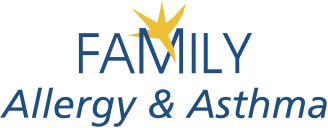Latex Allergy
Natural rubber latex is a milky fluid found in rubber trees. The problem is not with the rubber itself but a contaminating protein in the rubber. Natural rubber latex is used to make some gloves, condoms, balloons, rubber bands, erasers, and toys. Latex can also be found in bottle nipples and pacifiers. It may be surprising, but latex paints do not contain any natural rubber latex protein.
Latex allergy was unusual until the late 1980s, when more healthcare workers began using powdered latex gloves to control infections. In the 1990s, manufacturers found ways to make gloves with synthetic latex and/or powder-free, so the number of new cases has decreased.
Reactions to Latex
Allergy symptoms are the result of a chain reaction that starts in the immune system. Your immune system controls how your body defends itself. If you have an allergy, your immune system identifies something typically harmless as an invader or allergen. It overreacts with latex allergy by producing antibodies called Immunoglobulin E (IgE) that can react with proteins found in the natural rubber latex. These antibodies travel to cells that release chemicals, causing an allergic reaction. This reaction usually appears in the nose, lungs, throat, sinuses, ears, stomach lining, or skin.
People with this allergy have symptoms such as urticaria or hives, itching or flushing, swelling, sneezing, runny nose, cough, wheeze, shortness of breath, chest tightness, nausea, dizziness or lightheadedness. Any combination of these symptoms can be a sign of anaphylaxis (an-a-fi-LAK-sis), a life-threatening reaction that needs immediate medical attention.
Certain other chemicals used to make latex gloves can cause a delayed onset rash which only forms where the material touches the skin. This is called contact dermatitis. Red, itchy bumps or blisters usually appear within 12 to 48 hours. These symptoms are irritating but not life-threatening.
Latex can also become airborne and cause respiratory symptoms. For example, latex proteins can attach to the cornstarch powder used in latex gloves. As powdered latex gloves are used, the starch particles and latex allergens become airborne, where they can be inhaled or come into contact with your nose or eyes and cause symptoms. High concentrations of this allergenic powder have been measured in intensive care units and operating rooms. Using non-powdered latex gloves or synthetic (vinyl, nitrile) gloves reduces the risk of these reactions. Latex products – especially gloves – to cause allergic reactions varies enormously by brand and by production lot.
Treating Latex Allergy
The first step in treating latex allergy is being aware of the problem. At Midwest Allergy in Columbus, Ohio, our allergist have the knowledge and experience to diagnose the problem and develop a treatment plan.
We may prescribe an antihistamine to take for mild latex allergy symptoms. Your allergist may also prescribe epinephrine to keep with you if you have a severe reaction to latex. Your physician can help you decide whether you should wear a bracelet that alerts people about your allergy.
If your allergy is severe, it is essential to tell your family, employer, school personnel, and healthcare providers about your allergy. If you need surgery, ask that everything be latex-free.
If you have trouble breathing when you are around latex, stay away from areas where powdered gloves are used and avoid all direct contact with latex.
If you need to wear gloves, try substituting vinyl or nitrile gloves for latex. Synthetic latex gloves do not contain natural latex and are another option. These work in nearly all situations, including surgery, but they may be more expensive. If you tend to get a skin rash reaction to latex, latex gloves made without additional chemicals may be a good choice.
Latex condoms may cause severe allergic reactions in some people. If either partner has a latex allergy, synthetic rubber condoms are the best choice, although natural skin condoms may be used.
Who is Most at Risk?
Healthcare and rubber industry workers are at more risk for developing serious allergic reactions to latex. Also at increased risk are people who have had multiple medical procedures or surgeries. This is because the greatest danger of a severe reaction happens when latex comes in contact with moist areas of the body, such as during surgery.
If you have a latex allergy, you also have a greater risk of being allergic to certain foods, including bananas, avocados, kiwi fruit, and European chestnuts. These foods and latex share specific proteins, which cause a reaction in people with this allergy.
Tips for those with Latex Allergies
- People who react to latex typically develop a skin rash. This is irritating but not life-threatening.
- There is no cure for latex allergy. People with severe reactions must avoid latex.
- If you have trouble breathing when you are around latex or get a combination of symptoms, get immediate medical attention. These symptoms include hives, itching or flushing, swelling, sneezing, runny nose, cough, wheeze, shortness of breath, chest tightness, nausea, dizziness, or lightheadedness.
- An allergist is the best physician to determine if you are allergic to latex.
- The 1990 Americans with Disabilities Act (ADA) covers people with severe allergies to substances such as latex. Talk with your employer about your options.
Feel Better. Live Better.
An allergist is a pediatrician or internist with at least two additional years of specialized training in diagnosing and treating problems such as allergies, asthma, autoimmune diseases, and the evaluation and treatment of patients with recurrent infections, such as immunodeficiency diseases.
The proper care can make the difference between suffering from an allergic disease and feeling better. By visiting Family Allergy at one of our many locations in and near Columbus, Ohio, you can expect an accurate diagnosis, a treatment plan that works, and educational information to help you manage your disease.
